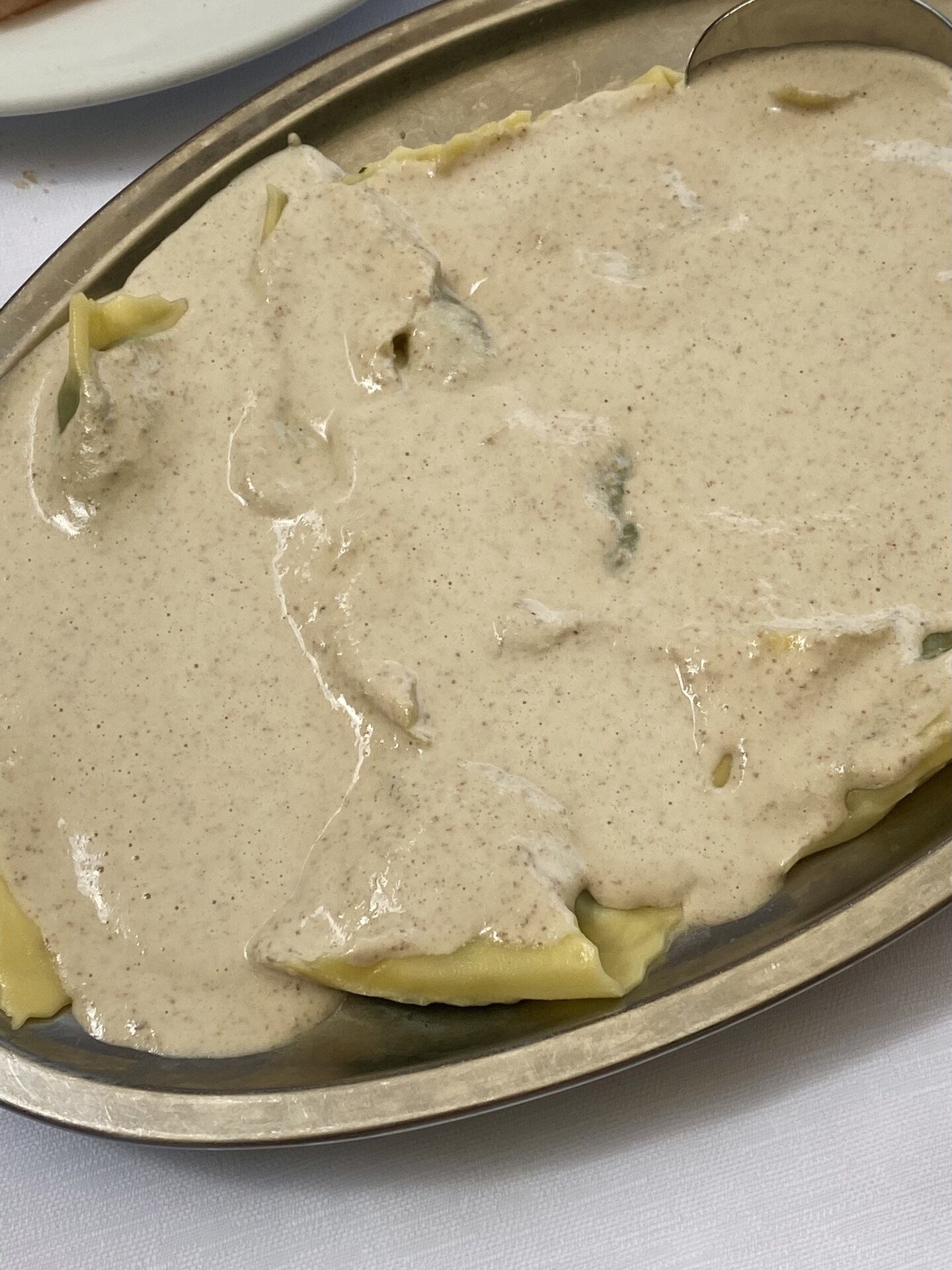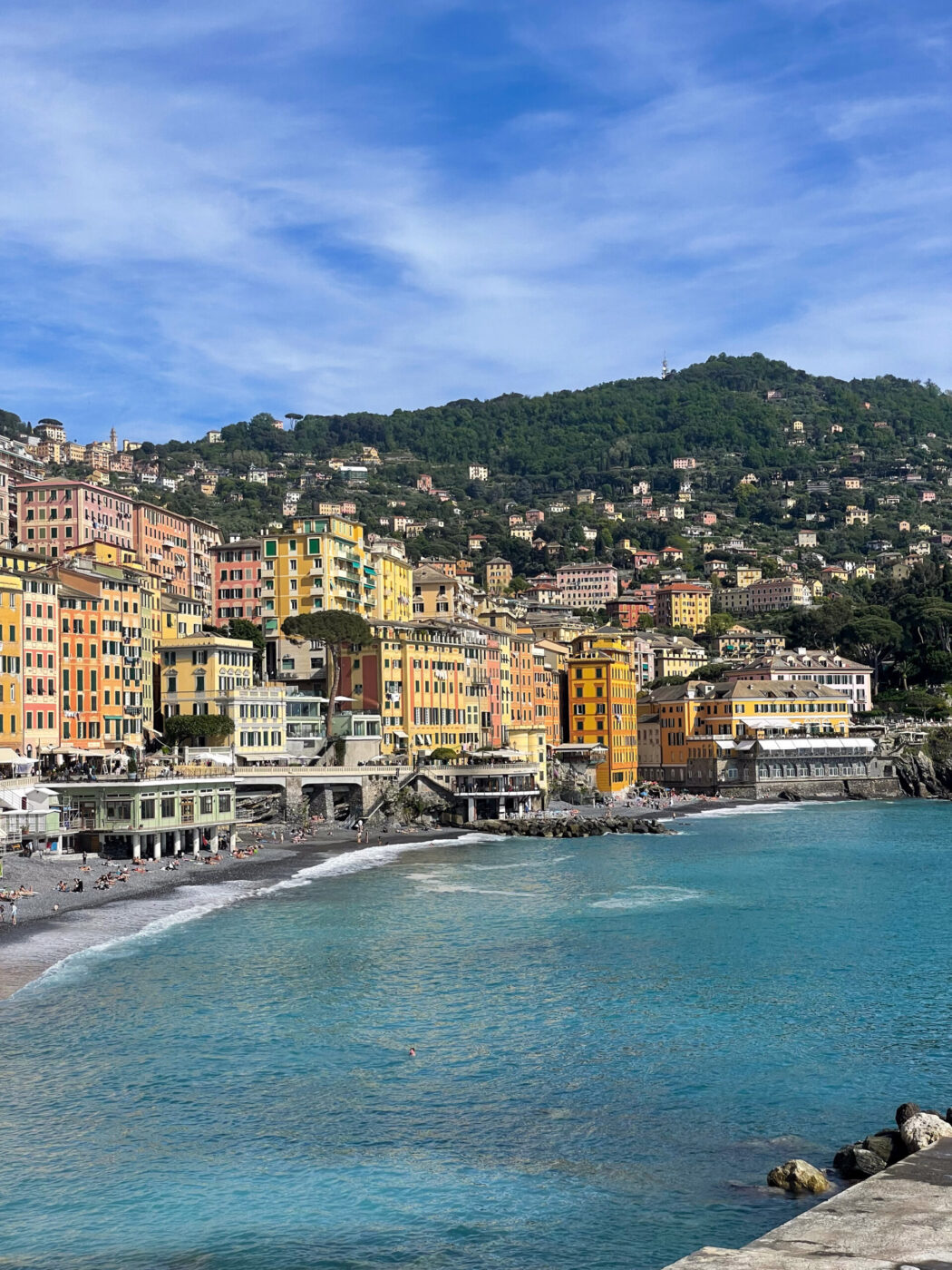It’s beige and a little wan, but like many beloved brown foods, every spoonful of salsa di noci tastes like, “Why don’t I eat this more often?” The predecessor of pesto alla genovese by at least 300 years, Ligurian walnut sauce is, of course, made with nuts, used to dress pasta, and traditionally pestata (i.e. “pounded” with a mortar and pestle). And yet, it is not called pesto—that name is reserved for salsa di noci’s more popular and admittedly far more beautiful little brother made with basil and pine nuts.
Thankfully, they don’t always eat for aesthetics in the crescent-shaped Italian region that cradles the sea, where la salsa di noci is nearly as common as basil pesto. As Vittorio Bisso of Da Ö Vittorio, a family-owned restaurant in Recco, simplifies Liguria’s stance on walnut sauce: “It’s less famous, but we like it.”
Food writer and cookbook author Enrica Monzani says that salsa di noci was first born as agliata con noci, a centuries-old Roman sauce of garlic and olive oil with the addition of walnuts. Over time, pine nuts found their way into the sauce to sweeten up the slightly bitter walnuts, as did fresh marjoram, which Monzani says is the queen to Liguria’s king herb, basil.
From this salsa di noci base, which can be traced back to cookbooks from the 1500s, the recipe can go one of two ways, says Roberto Cortona, the chef at Ristorante da Lino in Recco. The true recipe uses just milk-soaked bread and a touch of cheese (either Parmigiano or Grana Padano) for creaminess, but some restaurants may instead add butter and cream to cater to gluten-free diners and stretch the shelf life of the sauce. “Decisamente,” Cortona says, he prefers the more delicate, subtly acidic taste of the original recipe.
Yet another way to make salsa di noci, Monzani explains, is more common in the east of Liguria, where the sauce gets an extra dose of unctuousness from prescinsêua. This fresh local cheese is a touch more sour than ricotta, made—and found almost exclusively—in Liguria Levante, particularly the backcountry of Genova and the Gulf of Tigullio.
When making salsa di noci at home, Monzani likes the milk-and-bread version favored on the coastal side of Liguria, especially in the Golfo Paradiso towns of Camogli and Recco. In the time it takes to cook some pasta, she combines softened bread, walnuts, pine nuts, garlic, cheese, and marjoram in an electric mixer, then stirs the thick sauce with hot pasta water until dreamily creamy. Wondering if you should peel or toast the walnuts first? No need, Monzani says, as the skins give the sauce a pleasantly gritty consistency and a little more color, and raw nuts have the purest flavor.
“I’m really happy with this last-minute recipe that is so easy to make and even sticks to tradition,” says Monzani. “Of course, we don’t use the mortar anymore, we use a blender now, but the steps are still the same.”

Pansoti in Noci
With that shameless admission, Monzani points out yet more appeal of salsa di noci to home cooks: unlike pesto alla genovese, walnut sauce is basil-free and doesn’t need to be ground with a mortar and pestle—because there’s no need to worry about the heat of the blender turning the herbs black.
Whether pounded or blended, salsa di noci is rich, nutty, and umami with a touch of sweetness—an all-purpose sauce. In the Golfo Paradiso, it’s primarily used to dress pansotti, a “pot belly”-like pasta stuffed with ricotta and preboggion, a combination of wild herbs and greens. Preboggion, named after the Ligurian word for “pre-boil” (since the herbs must be boiled before consumption), is a slowly fading tradition. The farmers who know how to forage for borage, nettles, and other seasonal greens along rural roads and streams are becoming fewer and far between, but if you have the chance to taste true pansotti filled with slightly bitter and earthy preboggion (as opposed to neutral spinach and chard), you’ll understand why creamy walnut sauce is seen as their number one companion.
But don’t limit yourself—walnut sauce is perfect with any fresh or dried pasta and can also be served in other ways. Monzani likes it with a semi-whole wheat pasta called trenette avvantaggiate, which has the “advantage” of being cheaper to make than refined flour pasta, and she also spreads it on roasted onions. Or, take a cue from the Persians, who introduced Ligurians to walnuts and walnut sauce about 1,000 years ago and liked to serve it on lamb and poultry. Similarly, Georgians have bazhe and Mexicans have nogada, both used to top chicken.
Though it’s not a competition, there are good reasons to choose salsa di noci over pesto the next time you’re in need of pasta with a nutty sauce. First, walnut sauce is the ultimate pantry condiment; you needn’t wait for basil season to make it. Second, a bulky bag of walnuts goes much further than a small sleeve of precious, pricey pine nuts. Third, walnuts are good for your brain, which will hopefully remind you to use those noci languishing in your pantry for a bowlful of beautifully beige pasta.
IN CUCINA: PASTA CON SALSA DI NOCI
Serves 8
INGREDIENTS
- 700 g pansotti (or 800 g dried pasta, shape of your choice)
- 1 thick slice white country bread (about 35 g)
- 100 ml milk
- 150 g walnuts
- 25 g pine nuts
- 1 small garlic clove, peeled and minced
- 20 g Parmigiano Reggiano, grated
- 50 ml Ligurian olive oil
- 3 sprigs fresh marjoram
- Salt, to taste
PREPARATION
- Put a pot of salted water to boil.
- Remove the crust from the bread if it’s quite thick. Place the bread into a shallow dish and cover with the milk. Let sit for 5 minutes, or until it’s soaked through.
- Meanwhile, add the walnuts, pine nuts, garlic, Parmigiano, olive oil, one sprig’s worth of marjoram leaves, and salt to a blender or food processor.
- Add the soaked bread to the mixer, leaving the excess milk in the dish.
- Blend the walnut sauce until thick and mostly smooth, adjusting the salt for flavor.
- Cook pasta until al dente, and blend about 60 ml of pasta water into the walnut sauce. If the sauce is too thick, you add more olive oil or milk for consistency.
- Mix walnut sauce with the pasta, garnish with a few marjoram leaves, and serve.




